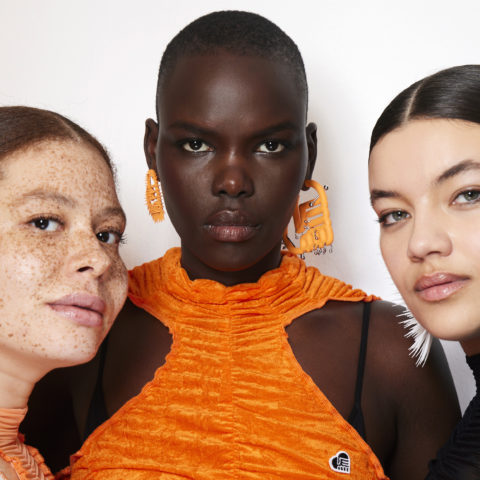Side parts, middle parts, no parts: Backstage tricks for achieving the top hair trends for spring


What’s in a hair part? A whole lot, according to the Spring 2013 runways. Celia Ellenberg reports.
To part, or not to part? That was the question that many coiffing stars seemed to be asking themselves this season as deep side parts, centre parts and no parts at all gave equally convincing performances on the spring runways. Why all the deliberate differentiation? “When I choose the part for a designer at a show or on a shoot—whether it’s a side or centre part, clean or messy—I always think about the character we’re conveying, the identity of the brand and every other little detail,” says Redken creative consultant Guido Palau.
“It’s an easy way to change a woman’s look without too much of a change,” says hairstylist Odile Gilbert, who also points out that hair parts can carry cultural, historical or geographical significance. “I don’t know if I’d go that deep,” says Orlando Pita, who proposes that specific parts are simply meant to draw the eye in specific ways. “Partings command a certain attention from the viewers.” Not to mention from the wearers. Here, the experts weigh in on how hair parts help define who we are and who we’d like to be.

Time and Place: Gilbert created a perfectly partitioned “strict” and “graphic” middle part at Thakoon that segued into long, cascading ridges coated with Kérastase Elixir Ultime the Imperial and secured with a hair tie at the ends. For Gilbert, centre parts scream 1960s and India.
Mixed Messages: The buzzwords “futuristic” and “contemporary” led Palau to create similarly sleek, split-down-the-middle styles at Alexander Wang and Jil Sander. He transitioned into softer, messier variations at Versace, Roberto Cavalli, Balenciaga and Bottega Veneta to reflect the “natural” feeling of those collections.
Hiding Spot: “Sometimes I just use a middle part to fix things,” says Pita, who crafted a precise centre part and soft waves at J. Mendel. “It makes things symmetrical if you have a big nose, a specific hair line or a cowlick.”

Line Drive: “Someone who does a straight part is someone who is a little compulsive,” says Pita. This character assessment applies to the side part he gave models at Michael Kors: “No hair out of place” was the description that came along with Kors’s “’60s-meets-’90s” directive. Painstakingly straight blowouts were tamed with T3 Control Heat-Seeking Hair Spray, tucked behind the ears and held in place with long elastics attached with clips across the lengths. “If the hair is really simple, you only have a part to convey your message.”
Big Mess: Two muses guided the low, messy side parts that took hold at Marc Jacobs, Chloé, Valentino and Louis Vuitton: Warhol superstar Edie Sedgwick and original supermodel Twiggy. “In the ’60s, women tried to get as much volume as possible,” Palau says. “The deeper the side part is, the more volume you will be able to get away with on top.” He employed this technique from New York to Paris, often enlisting Redken Powder Refresh 01 to give the hair grip before teasing it for texture.

Austerity Plan: “Your focus never goes to the hair if there’s no part. You kind of erase that thought when you scrape the hair straight back,” says Pita, who did just that at Giambattista Valli. “The deep side part looks a little more grown-up, the centre part is more defiant and really young, but this is more austere and a little streamlined.” He slathered hair with L’Oréal Professionnel Mythic Oil, then pulled it away from the hairline and left it hanging down past the models’ shoulders.
Upper Crust: Gilbert applied a similar aesthetic at The Row, with a whimsical style that culminated in an unstructured chignon. “A bit of forehead with a little volume gives a softness,” she says. “We call that aristocrat hair.”
East Village: The look isn’t just for the manor-born, though: Palau worked the no-part at Rag & Bone, where downtown cool girls have long ruled the runway. “It was a combination of strong and soft,” he says—a tribute to the kind of woman who is “not simple.” The dual-textured style had a slicked-back top section treated with Redken Hardwear 16 Super Strong Gel, and a matte dryness through the lengths.
Punk’d: A similarly complex woman reigned at Rodarte, where Gilbert used Kérastase Ciment Thermique to get a wet finish before flipping all the hair over to one side. “We did no partings—we wanted the other side of the hair to give it a shape,” she says. “It was a bit punk in a way, like one side had absolutely no hair. I loved that it was a bit unexpected.”










